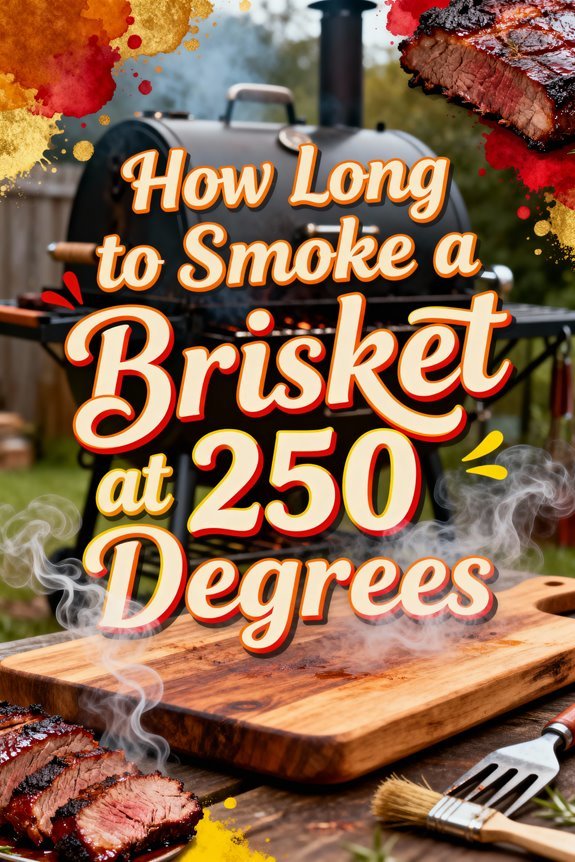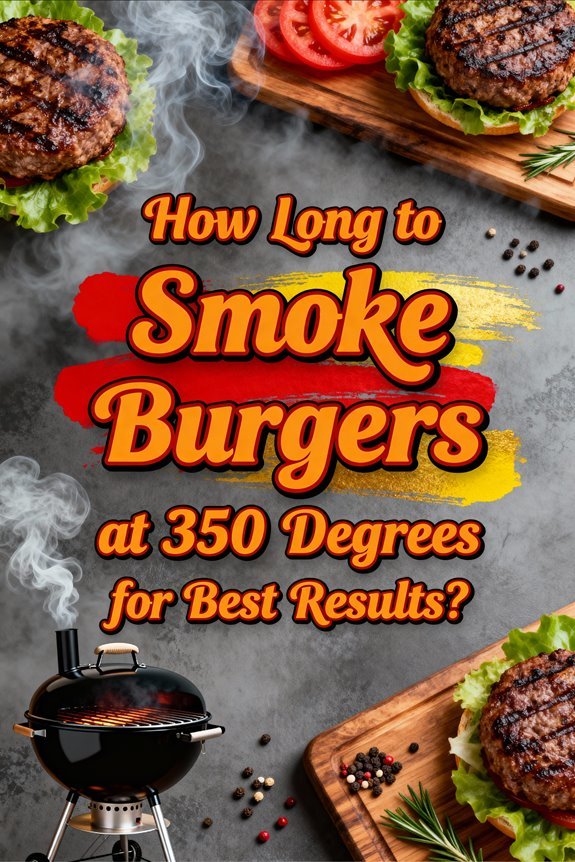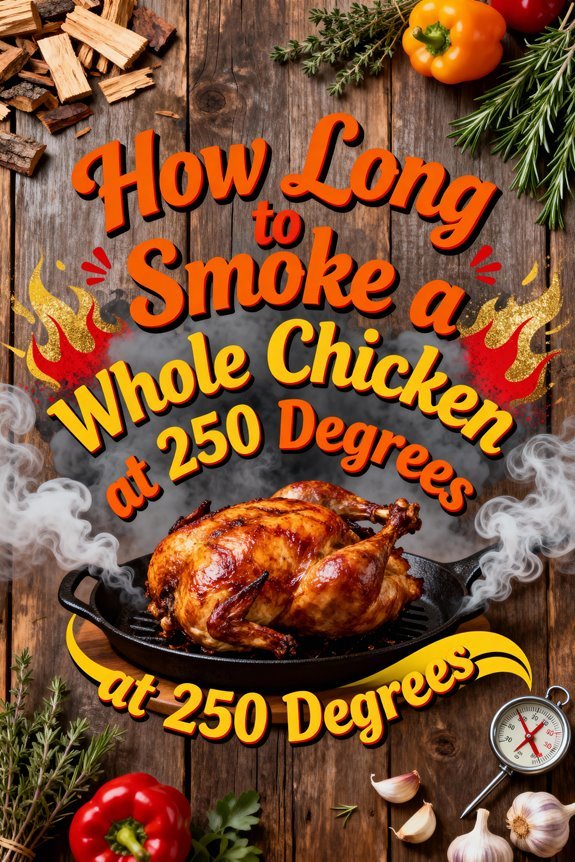You’ll need 1 to 1.5 hours per pound when smoking brisket at 250°F, so expect a 10-pound cut to take 10-15 hours total. Don’t rely solely on time—you’re aiming for an internal temperature of 200-205°F in the thickest part of the flat. The brisket’s done when your probe slides through like butter, indicating properly rendered connective tissue. Variables like meat thickness, fat content, and ambient conditions affect timing, so monitoring temperature and tenderness proves more reliable than watching the clock for achieving competition-quality results.
General Smoking Time Guidelines at 250°F
When you’re smoking a brisket at 250°F, plan for 1 to 1.5 hours per pound as your baseline estimate. A 10-pound brisket will typically require 10 to 15 hours total cook time. This temperature reduces cooking duration by 25–35% compared to lower smoking techniques at 225°F, while still maintaining excellent results.
However, don’t rely solely on time calculations. Actual duration varies greatly based on meat thickness, fat content, and your smoker’s temperature stability. Meat selection matters—higher grades with better marbling may cook differently than leaner cuts. The “per pound” rule serves as a rough planning guide, not an absolute predictor. During cooking, you may encounter a temperature stall period where the internal temperature plateaus around 150-160°F. Most pitmasters target internal doneness temperature between 190°F and 205°F.
Always verify doneness with a reliable thermometer rather than clock-watching. Your brisket’s internal temperature and probe tenderness determine true completion, not elapsed hours. After cooking, it’s important to let the meat rest to allow juices to redistribute throughout the brisket.
Factors That Affect Brisket Cooking Duration
While planning based on weight provides a useful starting point, multiple variables greatly influence your brisket’s actual cooking duration. Brisket thickness and cut type—whether you’re smoking a flat or point—affect heat penetration rates more than weight alone. The cooking environment matters considerably; ambient temperature, humidity, and your smoker’s ability to maintain steady heat all impact timing. Fat content and marbling require extended cooking periods to properly render into gelatin, essential for tenderness. Collagen-rich cuts demand patience through the stall phase, where evaporative cooling temporarily halts temperature rise. Individual animal variables like breed, diet, and muscle density create unpredictability even when following identical smoking protocols. The type of smoker you use affects average smoking time significantly, as different models distribute heat and smoke with varying efficiency. Understanding these factors helps you anticipate variations rather than rigidly adhering to time-per-pound calculations. Achieving the perfect bark formation typically occurs when the internal temperature reaches 160-170°F, signaling the ideal time to wrap the brisket. A well-executed smoke can take between 12 to 18 hours for a standard 12-14 pound brisket at lower temperatures.
Preparing Your Brisket for the Smoker
Before you introduce your brisket to smoke and heat, proper preparation determines whether you’ll achieve competition-quality results or disappointing, dry meat. Your brisket selection starts with choosing a whole packer weighing 10-14 pounds with good marbling and uniform thickness. Trim the fat cap to 1/4 inch, removing hard fat that won’t render and any silver skin that blocks smoke penetration. Low temperature smoking allows connective tissue to break down properly for tender results.
For seasoning techniques, apply a simple rub of kosher salt and coarse black pepper, optionally adding garlic powder for depth. Use a light binder like mustard to help the rub adhere. Refrigerate the seasoned brisket for at least one hour—overnight is better—allowing the salt to penetrate the meat. Trim cold meat for easier handling and more accurate identification of fat versus muscle. Consider adding smoked paprika to your rub for an extra layer of smoky flavor before cooking. This foundational preparation sets the stage for successful low-and-slow smoking.
The First Four Hours: Establishing the Foundation
The first four hours of smoking establish your brisket’s flavor foundation and structural integrity through careful temperature management and smoke application. You’ll maintain 250°F while positioning the brisket fat cap up for maximum heat protection. Use dry hardwoods like oak or mesquite in smaller pieces to develop smoke flavor without overwhelming the meat. Monitor your internal temperature closely, targeting 160-170°F by hour four as the brisket bark begins forming through the Maillard reaction. Much like achieving perfect pork tenderloin doneness at 145°F, temperature monitoring is crucial for optimal results. Similar to how ice cube placement keeps burgers moist during grilling, proper temperature control helps retain the brisket’s natural juices.
Keep your smoker’s airflow steady to prevent creosote buildup while avoiding unnecessary lid openings that disrupt temperature stability. The meat will dry slightly on the surface—this is essential for proper bark development. If edges appear too dry, spray with apple cider vinegar and water to maintain surface moisture while preserving smoke penetration. Baste with rendered fat throughout this initial phase to maintain moisture and enhance the developing flavor profile.
When and How to Wrap Your Brisket
Once your brisket hits the stall—that frustrating plateau where internal temperature refuses to climb past 150-170°F—you’ll need to decide whether to wrap. Most pitmasters initiate brisket wrapping at 165–170°F internal temperature, though you can also watch for surface moisture to dry as your signal. Use two sheets of pink butcher paper for best moisture preservation while maintaining bark integrity, or substitute foil for a tighter seal and softer finish. Wrap tightly with fat side up, optionally adding warmed beef tallow before sealing. Return the wrapped brisket to your smoker, positioning the flat toward the heat source. Continue cooking until probe-tender at 200–208°F. This technique—often called the Texas Crutch—accelerates cooking through the stall while preventing moisture loss during extended smoke times. Keep in mind that wrapping may result in a slight loss of smoke flavor compared to an unwrapped brisket, though the tradeoff is faster cooking and improved moisture retention. Similar to smoking beef ribs, using heavy smoking wood during the initial hours helps develop robust flavor before wrapping. Like the reverse sear method used in steak smoking, this two-stage cooking process helps achieve the perfect balance of flavor and tenderness.
Target Internal Temperatures for Perfect Tenderness
Wrapping protects your brisket through the stall, but knowing when to pull it from the smoker determines whether you’ll serve fork-tender slices or disappointing shoe leather. Your target internal temperature should be 200–205°F in the thickest part of the flat. These ideal pull temperatures allow collagen to fully break down while maintaining moisture retention. Don’t rely solely on numbers—probe the meat for tenderness. It should slide through like softened butter with minimal resistance. Pulling below 190°F leaves connective tissue undercooked and tough. Going beyond 208°F risks drying out the brisket entirely. Using a water pan helps maintain moisture during faster cooking sessions. Just like propane valve safety is crucial when changing tanks, maintaining consistent temperature control throughout the cook ensures optimal results. Remember that carryover cooking adds 5–10°F during rest, so factor this into your pull decision. Each brisket’s unique marbling and thickness means probe tenderness ultimately trumps temperature readings alone. After reaching the target temperature, let the brisket rest for at least 1 hour before slicing to allow juices to redistribute throughout the meat.
Using Probe Tenderness as Your Guide
How do you know when your brisket has crossed the finish line from tough to fork-tender? Probe tenderness is your most reliable indicator. Insert a metal probe or thermometer into the thickest part of the point muscle—it should slide through like butter with zero resistance. Temperature alone won’t tell you everything, since thickness variations affect doneness throughout the meat.
Start your testing techniques around 190°F internal temperature. Push the probe fully into the center of the thickest section, holding it for 10 seconds to stabilize. Test multiple spots to confirm consistency. If you feel resistance beyond soft butter, continue cooking. When the probe glides effortlessly through and the brisket feels gelatinous when lifted, you’ve achieved ideal tenderness—typically between 195°F and 205°F. Some old-timers prefer using finger pressure to check for doneness as an additional verification method. The low and slow cooking process allows collagen to break down properly, transforming naturally tough meat into a tender finished product. Much like pre-cooking ribs at 275-350°F helps tenderize the meat before grilling, this extended cooking process ensures the brisket reaches optimal tenderness.
Fire and Smoke Management Best Practices
While probe tenderness reveals when your brisket is done, mastering fire and smoke management determines whether you’ll reach that finish line successfully. You’ll need to stabilize your pit at 250°F by adjusting intake and exhaust vents—open vents increase airflow and temperature, while closing them reduces both. Keep your fuel consistent; adding small amounts of wood regularly prevents temperature spikes that’ll dry out your meat. Just as foil wrapping helps seal in moisture when grilling corn, proper temperature control is essential for juicy results.
Clean, thin blue smoke creates that coveted smoke ring and delivers proper flavor. Thick white smoke indicates incomplete combustion and produces bitter, acrid flavors you’ll want to avoid. Place a water pan inside to maintain humidity levels, which enhances smoke penetration and prevents surface drying. The water pan also slows moisture evaporation from the brisket surface while helping to regulate pit temperature fluctuations. For enhanced flavor profiles, consider using fruit wood pellets like apple or cherry which provide subtle sweetness without overpowering the meat.
Monitor your fire throughout the cook, maintaining fire safety by keeping extinguishing equipment nearby and never leaving your smoker unattended during extended cooking sessions.
Resting Your Brisket After Smoking
After you’ve managed your fire perfectly and pulled your brisket at the right probe tenderness, don’t make the rookie mistake of slicing into it immediately. You need at least one hour of rest, though 2-3 hours is ideal for maximum moisture retention. Proper resting techniques involve wrapping tightly in foil or plastic wrap, then insulating with towels. For extended rests beyond an hour, use an insulated cooler to maintain safe temperatures above 140°F and prevent bacterial growth. During this period, muscle fibers relax and reabsorb expelled juices, while the bark sets properly. The resting phase also allows collagen to continue gelatinizing, further enhancing tenderness. Just like low and slow cooking allows smoke to properly infuse meat at 225°F, proper resting is essential for optimal results. Some pitmasters rest for 8+ hours in coolers before service. Cut too soon, and you’ll watch precious juices pool on your cutting board instead of staying in the meat. Just like with tender chicken thighs, letting meat rest ensures the juices redistribute evenly throughout for maximum flavor and moisture.
Common Timing Mistakes to Avoid
The single biggest timing mistake pitmasters make is treating brisket like it runs on a clock. You’ll undercook or overcook every time if you’re watching hours instead of internal temperature. Your brisket’s done when it hits 195°F-205°F internally—not at some predetermined time mark.
Common temperature errors compound timing problems. Smoking outside the 225°F-250°F range throws off your entire cook, making time predictions worthless. Offset smokers running at 275°F-280°F cook faster than pellet smokers at 225°F. Using apple cider vinegar during the smoking process helps maintain optimal moisture levels. Like a room temperature steak, letting your brisket warm up before smoking ensures even cooking throughout.
Don’t rush the process by cranking heat. Larger briskets need more time; smaller ones finish sooner. Monitor ambient temperature too—cold weather extends cooking time markedly. Allocate ample time for both smoking and resting your brisket to avoid scheduling conflicts.
Use a wireless thermometer rather than guessing. Proper smoke flavoring requires consistent heat, which directly affects timing accuracy.







